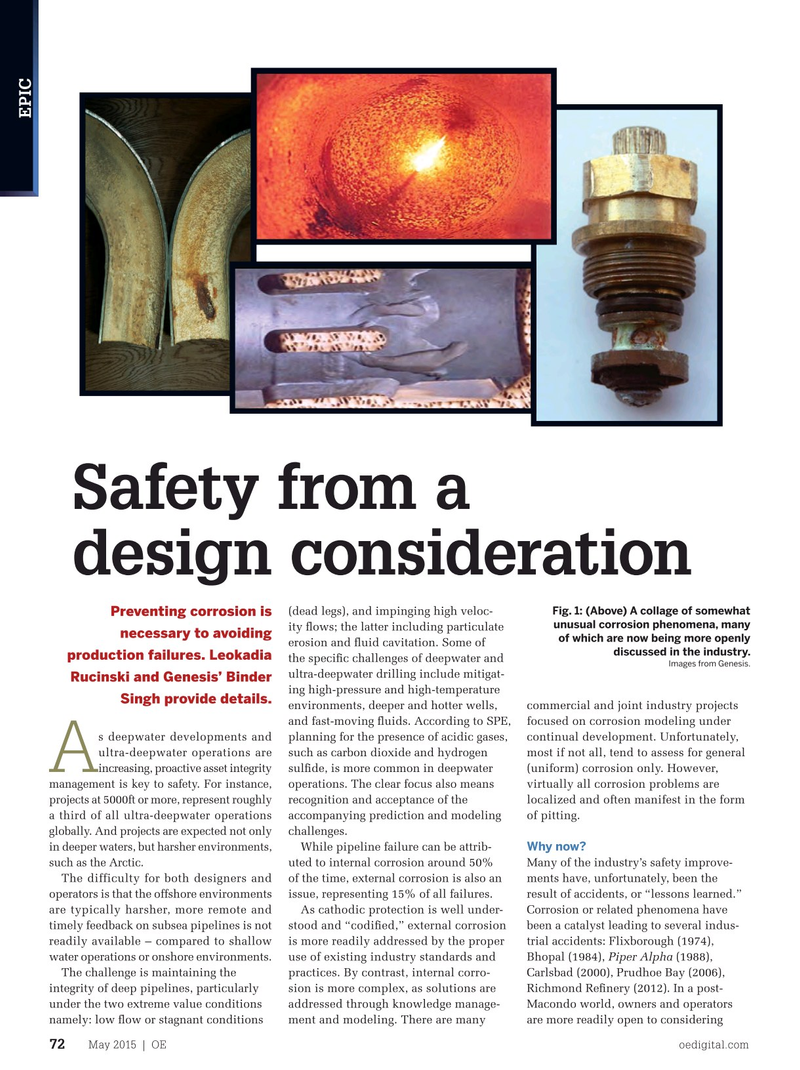
Page 70: of Offshore Engineer Magazine (May/Jun 2015)
Read this page in Pdf, Flash or Html5 edition of May/Jun 2015 Offshore Engineer Magazine
such new approaches early on (capex phase).
Offshore corrosion case histories have not always been readily available, but
EPIC the better exchanges of quantifable data have led to software development with analytics and searchable benchmarking. (See collage, fgure 1.)
The main root cause of the devasting 1988 accident at Piper Alpha has primarily been attributed to a failure of the permit to work. However, delving further, the planned maintenance work order was due to serious corrosion issues, which were deferred for many years to avoid interruption of production activities.
Since Piper Alpha, many changes have taken place in the industry, and the North
Sea region has seen many successes, and hopefully a de facto alignment of the North
Sea and Gulf of Mexico regions will help improve matters further, for the industry as a whole. The results of better overall fab- ric maintenance testing, inspection, more creative monitoring, and pipeline pigging will be a big plus.
Managing corrosion
Safety from a and asset integrity
Managing corrosion and the integrity of deep pipelines is a three-fold process: proactive, ongoing and reactive. design consideration
Proactive work is becoming more com- mon and considered economically more
Fig. 1: (Above) A collage of somewhat (dead legs), and impinging high veloc- rational. According to NACE, corrosion-
Preventing corrosion is unusual corrosion phenomena, many ity fows; the latter including particulate related costs for monitoring, replacing necessary to avoiding of which are now being more openly erosion and fuid cavitation. Some of and maintaining pipelines are estimated discussed in the industry. production failures. Leokadia the specifc challenges of deepwater and around a staggering $450 billion for the
Images from Genesis.
ultra-deepwater drilling include mitigat-
Rucinski and Genesis’ Binder ing high-pressure and high-temperature
Singh provide details.
environments, deeper and hotter wells, commercial and joint industry projects and fast-moving fuids. According to SPE, focused on corrosion modeling under s deepwater developments and planning for the presence of acidic gases, continual development. Unfortunately, ultra-deepwater operations are such as carbon dioxide and hydrogen most if not all, tend to assess for general
A increasing, proactive asset integrity sulfde, is more common in deepwater (uniform) corrosion only. However, management is key to safety. For instance, operations. The clear focus also means virtually all corrosion problems are projects at 5000ft or more, represent roughly recognition and acceptance of the localized and often manifest in the form a third of all ultra-deepwater operations accompanying prediction and modeling of pitting. globally. And projects are expected not only challenges.
Why now?
in deeper waters, but harsher environments,
While pipeline failure can be attrib- such as the Arctic.
uted to internal corrosion around 50% Many of the industry’s safety improve-
The difficulty for both designers and of the time, external corrosion is also an ments have, unfortunately, been the operators is that the offshore environments issue, representing 15% of all failures. result of accidents, or “lessons learned.” are typically harsher, more remote and As cathodic protection is well under- Corrosion or related phenomena have timely feedback on subsea pipelines is not stood and “codifed,” external corrosion been a catalyst leading to several indus- readily available – compared to shallow is more readily addressed by the proper trial accidents: Flixborough (1974), water operations or onshore environments. use of existing industry standards and Bhopal (1984), Piper Alpha (1988),
The challenge is maintaining the practices. By contrast, internal corro- Carlsbad (2000), Prudhoe Bay (2006), integrity of deep pipelines, particularly sion is more complex, as solutions are Richmond Refnery (2012). In a post- under the two extreme value conditions addressed through knowledge manage- Macondo world, owners and operators namely: low fow or stagnant conditions ment and modeling. There are many are more readily open to considering
May 2015 | OE oedigital.com 72 072_OE0515_EPIC4-Genesis.indd 72 4/20/15 4:00 PM

 69
69

 71
71